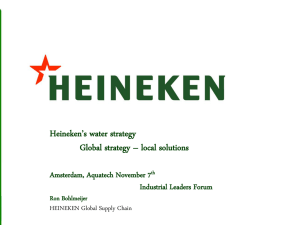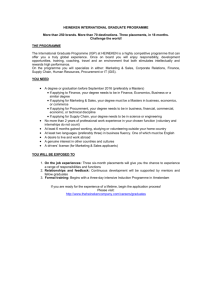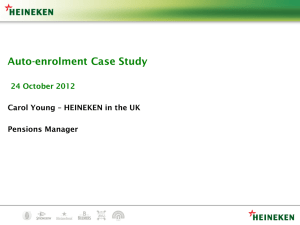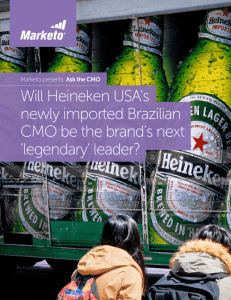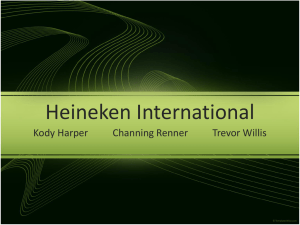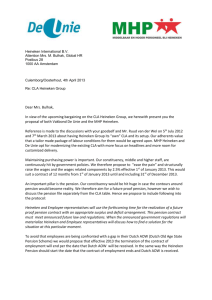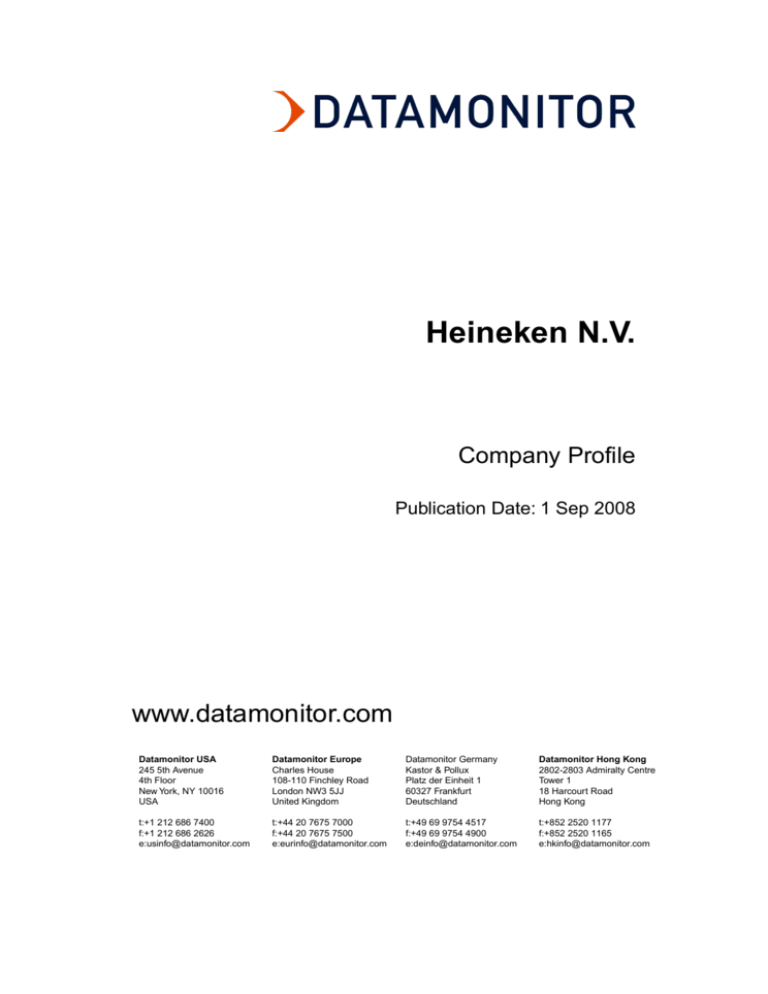
Heineken N.V.
Company Profile
Publication Date: 1 Sep 2008
www.datamonitor.com
Datamonitor USA
245 5th Avenue
4th Floor
New York, NY 10016
USA
Datamonitor Europe
Charles House
108-110 Finchley Road
London NW3 5JJ
United Kingdom
Datamonitor Germany
Kastor & Pollux
Platz der Einheit 1
60327 Frankfurt
Deutschland
Datamonitor Hong Kong
2802-2803 Admiralty Centre
Tower 1
18 Harcourt Road
Hong Kong
t:+1 212 686 7400
f:+1 212 686 2626
e:usinfo@datamonitor.com
t:+44 20 7675 7000
f:+44 20 7675 7500
e:eurinfo@datamonitor.com
t:+49 69 9754 4517
f:+49 69 9754 4900
e:deinfo@datamonitor.com
t:+852 2520 1177
f:+852 2520 1165
e:hkinfo@datamonitor.com
Heineken N.V.
ABOUT DATAMONITOR
Datamonitor is a leading business information company specializing in industry analysis.
Through its proprietary databases and wealth of expertise, Datamonitor provides clients with unbiased
expert analysis and in depth forecasts for six industry sectors: Healthcare, Technology, Automotive,
Energy, Consumer Markets, and Financial Services.
The company also advises clients on the impact that new technology and eCommerce will have on
their businesses. Datamonitor maintains its headquarters in London, and regional offices in New
York, Frankfurt, and Hong Kong. The company serves the world's largest 5000 companies.
Datamonitor's premium reports are based on primary research with industry panels and consumers.
We gather information on market segmentation, market growth and pricing, competitors and products.
Our experts then interpret this data to produce detailed forecasts and actionable recommendations,
helping you create new business opportunities and ideas.
Our series of company, industry and country profiles complements our premium products, providing
top-level information on 10,000 companies, 2,500 industries and 50 countries. While they do not
contain the highly detailed breakdowns found in premium reports, profiles give you the most important
qualitative and quantitative summary information you need - including predictions and forecasts.
All Rights Reserved.
No part of this publication may be reproduced, stored in a retrieval system or transmitted in any form by any means, electronic,
mechanical, photocopying, recording or otherwise, without the prior permission of the publisher, Datamonitor plc.
The facts of this profile are believed to be correct at the time of publication but cannot be guaranteed. Please note that the
findings, conclusions and recommendations that Datamonitor delivers will be based on information gathered in good faith
from both primary and secondary sources, whose accuracy we are not always in a position to guarantee. As such Datamonitor
can accept no liability whatever for actions taken based on any information that may subsequently prove to be incorrect.
Heineken N.V.
© Datamonitor
Page 2
Heineken N.V.
TABLE OF CONTENTS
TABLE OF CONTENTS
Company Overview..............................................................................................4
Key Facts...............................................................................................................4
Business Description...........................................................................................5
History...................................................................................................................7
Key Employees...................................................................................................10
Key Employee Biographies................................................................................11
Major Products and Services............................................................................15
Revenue Analysis...............................................................................................17
SWOT Analysis...................................................................................................18
Top Competitors.................................................................................................23
Company View.....................................................................................................24
Locations and Subsidiaries...............................................................................28
Heineken N.V.
© Datamonitor
Page 3
Heineken N.V.
Company Overview
COMPANY OVERVIEW
Heineken owns and manages one of the leading portfolios of beer brands. It brews and sells more
than 170 international premiums, regional, local and specialty beers, including Heineken, Amstel,
Cruzcampo, Tiger, Zywiec, Birra Moretti, Ochota, Murphy’s and Star. It operates in Europe, the
Americas, Africa, the Middle East and Asia Pacific. It is headquartered in Amsterdam, the Netherlands;
and employed about 54,004 people in fiscal year (FY) 2007.
The company recorded revenues of E12,564 million (approximately $17,222 million) during the fiscal
year ended December 2007 (FY2007), an increase of 6.2% over FY2006. The increase was primarily
attributable to the volume increase, improvements in sales mix and higher selling prices.The operating
profit of the company was E1,503 million (approximately $2,060.2 million) during FY2007, a decrease
of 16.7% compared with FY2006. The net profit was E807 million (approximately $1,106.2 million)
in FY2007, a decrease of 33.4% compared with FY2006.
KEY FACTS
Head Office
Heineken N.V.
1000 AA
Amsterdam
NLD
Phone
31 20 523 92 39
Fax
31 20 626 35 03
Web Address
http://www.heinekeninternational.com
Revenue / turnover 12,564.0
(EUR Mn)
Financial Year End
December
Employees
54,004
Amsterdam Ticker
HEIN
Heineken N.V.
© Datamonitor
Page 4
Heineken N.V.
Business Description
BUSINESS DESCRIPTION
Heineken is one of the world’s leading brewers, in terms of sales volume and profitability. The
company has a wide international presence through a global network of distributors and breweries.
Heineken is also the largest brewer and beverage distributor in Europe in terms of volume.
The company brews and sells more than 170 varieties of international premiums, regional, local and
specialty beers. Its principal brands are Heineken and Amstel. The company owns 119 breweries
and distributors in over 65 countries across Western Europe; Central and Eastern Europe; the
Americas; Africa and the Middle East; and the Asia Pacific region. The breweries are either owned
by the company or are joint ventures in different countries.
The company operates in five geographic segments: Western Europe, Central and Eastern Europe,
Americas, Africa and the Middle East and Asia Pacific.
In Western Europe, the company is an important beer brewer. It is the leader in the Netherlands
(48.7% of the total market share), Spain (31%) and Italy (31.1%); and the second largest player in
France (31.2%) and Ireland (22.2%). The company’s brands Heineken and Amstel are also brewed
under license or imported into several other Western European markets by Lion Nathan and others
brewers.
Brau Union is a subsidiary of Heineken in Central Europe and the largest brewing group in Central
Europe. It is the leading brewer in Poland, Austria, Romania, Slovakia, Bulgaria and Macedonia.
Brau Union also operates in Germany, Greece Hungary, Croatia and the Czech Republic. The
company offers brands such as Heineken, Edelweiss, Amstel, Alfa, Kujawiak, Buckler, Guinness
and Zlaty Bazant in this region.
In the Americas, the company primarily sells its products in the US, Central America and the Caribbean
through a number of its subsidiaries. It owns a number of breweries in the Caribbean and Central
America. The company also has interests in and licensing agreements with, several breweries in
Central and South America. Heineken USA is the exclusive importer, marketer, and seller of Femsa
Cerveza’s beer brands in the US, including Tecate, Dos Equis, Sol, Carta Blanca and Bohemia. It
also imports other brands including Heineken Lager, Amstel Light and Buckler. Heineken also owns
a 50% stake in the Chilean and Argentinean brewer, Compania Cervecerias Unidas. Some of the
company’s brands in this region include Heineken, Cordoba, Cristal, Presidente and Prestige.
In Africa, the company has a 54% stake in Nigerian Breweries and a 50% stake in Consolidated
Breweries, both local beer manufacturers. It also owns Al Ahram Beverages Company in Egypt,
which is the sole beer supplier in Egypt. Heineken, through its other operating companies, produces
and markets soft drinks besides beer, in Africa. The company distributes the following brands in this
region: Maltina, Gulder, Malt Star, Almaza, Killkenny, Bourbon and Star, among others.
Heineken N.V.
© Datamonitor
Page 5
Heineken N.V.
Business Description
The company operates in the Asia Pacific region through Heineken-Asia Pacific Breweries
(Heineken-APB), its Singapore-based joint venture with Fraser & Neave. Heineken-APB operates
breweries in Singapore, Malaysia, Thailand, Vietnam, Cambodia, China, New Zealand, Papua New
Guinea and Sri Lanka. The company’s Heineken brand is brewed at several of Heineken-APB’s
breweries throughout the region. In some countries, Heineken is brewed under licensing agreements
with several breweries. Other brands distributed in the Asia Pacific region include ABC Stout, Anchor,
Number One and Tiger.
Heineken N.V.
© Datamonitor
Page 6
Heineken N.V.
History
HISTORY
Heineken’s history dates back to 1864, when Gerard Adriaan Heineken purchased a brewery in
Amsterdam. This brewery was the largest of the 69 breweries in the region. A second brewery was
acquired in 1868. Heineken’s Bierbrouwerij Maatschappij (Heineken Breweries or HBM) was
incorporated in 1873. A phase of expansion followed in the 1880s.
In 1931, Heineken and Fraser & Neave in Singapore formed a joint venture named Malayan Breweries,
to operate a brewery in Singapore. In 1933, the company started exporting beer to the US. De
Sleuthel, a Netherlands-based brewer in Dordrecht was taken over by Heineken in 1953. A new
brewery was started in Hertogenbosch in 1954 and this was further expanded in 1959. The company
started the Kumasi Brewery in Ghana in 1961.
Heineken took over Amstel Brouwerji, along with a soft drinks producer Vrumona situated in Bunnik
(the Netherlands) in 1968. As a result of this takeover, Heineken acquired interest in six other
breweries around the globe. Heineken acquired a majority participating interest in the share capital
of Holding Company l’Esperance (the French ALBRA group), the third largest brewing group in
France in 1972.
Later, in 1979, Heineken increased its participation in the Dreher Group (Italy) from 90% to nearly
100%. At the same time, the company increased its interest in the ALBRA group to 100%. ALBRA
was then renamed Heineken France. The company shut down the Amstel brewery in Amsterdam
and transferred production to the Heineken brewery in Zoeterwoude in 1982. At the same time, the
company acquired Brouwerij de Ridder in Maastricht (the Netherlands) and doubled its interest in
several companies in Central Africa.
In 1983, Heineken entered into a brewing agreement with Coca-Cola bottlers in Brazil, to produce
Kaiser beer. Meanwhile, Kirin Brewery started brewing Heineken under license in Japan. The
company, through Asia Pacific Breweries, entered into a joint venture partnership for establishing
the Mila Brewery in Shanghai (China) in 1988. It also introduced Buckler alcohol free beer in France,
Spain, the Netherlands and Ireland. In 1990, Heineken acquired Van Munching, its sole importer in
the US. Two years later, Heineken increased its interest in Komaromi Sorgyar RT in Hungary to
55.3%. The company later acquired a 24.9% participating interest in the Polish brewery, Zywiec in
1994.
International expansion continued in 2002, when Heineken acquired 98% of the only brewer in Egypt,
Al Ahram Beverages Company (ABC). Also in 2002, it acquired a majority stake in Lebanese brewery
Almaza, a 25% stake in Costa Rican brewery Florida Bebidas and a 25% stake in Nicaraguan
brewery Consorcio Cervecero Centroamericano. Further growth was achieved in 2003, this time in
Europe. Heineken acquired a majority interest in Austrian based brewery BBAG. The operations of
BBAG and Heineken in the region were combined into a new company Brau Union. The company
purchased a 21% stake in a Chinese company, Guangdong Brewery Holdings, in 2004. In the same
year, the company sold its subsidiary Glas Moerdijk to Rexam Beverage Packaging.
Heineken N.V.
© Datamonitor
Page 7
Heineken N.V.
History
The company improved its position in the Australian beer sector in the same year by forming a joint
venture with Lion Nathan. This brought the companies together in a sales and distribution deal,
which involved the option to brew Heineken and potentially other Heineken company brands in Lion
Nathan Australia breweries. Furthermore, in the same year, the company replaced Interbrew, as a
partner of Formento Economico Mexicano (Femsa). It also formed Brandhouse, a joint venture in
South Africa with Diageo and Namibia Breweries. The company acquired 100% of the Russian
group, Central European Brewing Company and strengthened its position in the Russian market by
acquiring Sobol Beer in 2004. Finally, in the same year, Brau Holding International, Heineken’s joint
venture with the Schorghuber Corporate Group, acquired Furstlich Furstenbergische Brauerei and
Brewery Hoepfner.
During the early part of 2005, Heineken launched the Heineken Premium Light in the US and portable
draught beer system, the 4.75 liter Heineken Draught Keg. In the same year company made series
of acquisition including a 40% stake in Jiangsu DaFuHao Breweries (DaFuHao); Patra Brewery in
Russia; Baikal Beer Company, Stepan Razin and Ivan Taranov in, Russia. In the later part of 2005,
the company’s subsidiary Brau Union in Austria signed an agreement for the divestment of its real
estate division, which comprised non-business related real estate units. Heineken-APB, the company’s
joint venture with Fraser & Neave, acquired a 76% stake in Aurangabad Breweries in India in May
2006. In August 2006, Heineken’s subsidiary Heineken Espana, in Spain signed an agreement for
the divestment of the land and buildings of the current brewery site in Seville.
During October 2006, Heineken International launched its global advertising campaign, starring Eva
Green as Vesper Lynd in the new James Bond film Casino Royale. Two months later company
acquired 49.99% of the shares in the Tunisian company, Societe de Production et de Distribution
des Boissons. The joint venture company will invest in the construction of a new brewery and will
brew and distribute Heineken and local brands in Tunisia.
In March 2007, Heineken opened its first fully branded beer-focused outlet Heineken Bar in the new
Terminal 2 of Hong Kong International Airport. The new bar is aimed at international travelers, who
look for a branded and premium beer experience that they can share with others from around the
world. In the same month, Heineken launched its new advertising campaign for the Heineken brand
and the UEFA Champions League partnership, which established the new theme “Enjoyed together
around the world”. The new campaign created by The Red Brick Road, contained fourteen 10-second
break-bumpers featuring football fans enjoying Heineken and the Champions league together, in a
range of locations around the world. Eight of these exotic locations include Cook Islands, an igloo
in Nuuk, Greenland, the Calgary tower, Canada, and a boat floating in Shanghai busy harbor. The
other six break bumpers show a group of people enjoying Heineken DraughtKeg and the UEFA
Champions League in Manhattan, Moscow, New Zealand, Jamaica, at sea and even in space.
During April 2007, Heineken and Fomento Economico Mexicano announced that both have extended
their existing three-year relationship in the US for a period of ten years. Heineken will continue to
be sole and exclusive importer, marketer and seller of the FEMSA beer brands, Dos Equis, Tecate,
Tecate Light, Sol, Bohemia and Carta Blanca, in the US.
Heineken N.V.
© Datamonitor
Page 8
Heineken N.V.
History
In June 2007, Heineken launched its new campaign, entitled ‘Continental Shift,’ for the Rugby World
Cup 2007. In the same month, the company acquired Krusovice Brewery in the Czech Republic
from Radeberger Gruppe. As a result of this transaction, the market share of Heineken in the Czech
Republic increased to 8%, with total volumes of over 1.6 million hectoliters, improving Heineken’s
position in the market to number three.
In December 2007, the company entered into an agreement to acquire the Rodic Brewery, in Novi
Sad, Serbia. Also, during the same month, the company entered into a three-year marketing
partnership with Air France and KLM. Under the agreement, Heineken beer is the only beer to be
served on board flights operated by KLM and the majority of Air France flights. Further, the company
acquired the Cypriot holding company of the Syabar Brewing Company, in Bobruysk, Belarus in the
same month.
The company acquired the Tango Brewery in Algiers, Algeria from the Group Mehri in January 2008.
Also during the same month, the company formed a joint venture with Efes Breweries International
in order to invest in the Uzbek beer market through the acquisition of breweries. In the following
month, the company acquired the Romanian brewer Bere Mures.
In March 2008, Heineken, Diageo and Namibia Breweries entered into an agreement to form a new
joint venture for their combined beer, cider and RTD businesses in South Africa. Heineken and
Diageo will each own 42.25% of the new joint venture and Namibia Breweries will own 15.5%. In
addition, Heineken and Diageo formed a second joint venture in South Africa in the same month.
The new entity would construct and operate a brewery in Gauteng province, South Africa, and will
be owned 75% by Heineken and 25% by Diageo. Also, during the same month, the company acquired
the Drinks Union in the Czech Republic.
In April 2008, Heineken and Carlsberg acquired Scottish & Newcastle (S&N). In May 2008, the
company renewed its contract with UEFA to sponsor the UEFA Champions League for a further 3
years. Heineken would remain one of the principal sponsors of the tournament through to the end
of the 2011/12 season. Also during the same month, the company entered into an agreement to
acquire Rechitsa brewery in Belarus.
In August 2008, the company changed the accounting treatment of joint ventures in the financial
reporting from the proportional consolidation method to the equity method.
Heineken N.V.
© Datamonitor
Page 9
Heineken N.V.
Key Employees
KEY EMPLOYEES
Name
Job Title
Board
Jean Francois van Boxmeer
Chairman, Management Board
Executive Board
Rene Hooft Graafland
Chief Financial Officer
Executive Board
Cees van Lede
Chairman, Supervisory Board
Non Executive Board
Jan Maarten de Jong
Vice Chairman, Supervisory Board
Non Executive Board
Maarten Das
Member, Supervisory Board
Non Executive Board
Michel de Carvalho
Member, Supervisory Board
Non Executive Board
Jan Michiel Hessels
Member, Supervisory Board
Non Executive Board
Annemiek Fentener van Vlissingen Member, Supervisory Board
Non Executive Board
Ian Charter MacLaurin
Member, Supervisory Board
Non Executive Board
Mary M. Minnick
Member, Supervisory Board
Non Executive Board
Didier Debrosse
Regional President, Western Europe
Senior Management
Nico Nusmeier
Regional President, Central and Eastern Europe Senior Management
Thomas de Man
Regional President, Africa and Middle East
Senior Management
Massimo von Wunster
Regional President, Americas
Senior Management
Siep Hiemstra
Regional President, Asia Pacific
Senior Management
Frans van der Minne
Director, Group Human Resources
Senior Management
Sean O'Neill
Director, Group Corporate Relations
Senior Management
Marc Gross
Director, Group Supply Chain
Senior Management
Floris van Woerkom
Director, Group Control and Accounting
Senior Management
Heineken N.V.
© Datamonitor
Page 10
Heineken N.V.
Key Employee Biographies
KEY EMPLOYEE BIOGRAPHIES
Jean Francois van Boxmeer
Board: Executive Board
Job Title: Chairman, Management Board
Since: 2005
Age: 47
Mr. Boxmeer has been the Chairman of the Executive Board and Chief Executive Officer of Heineken
since 2005. He joined Heineken in 1984 and has held various positions in the Netherlands and
abroad. He also heads the company’s Heineken Brouwerijen, Heineken Nederland Supply, Heineken
Nederlands Beheer, Vrumona, Heineken Brewery Russia and Athenian Brewery operations.
Rene Hooft Graafland
Board: Executive Board
Job Title: Chief Financial Officer
Since: 2005
Age: 53
Mr. Graafland has been the Chief Financial Officer of Heineken since 2005. He was the Director of
Heineken Export Group from 2001 to 2002. He was Director of Corporate Marketing form 1997 to
2001.
Didier Debrosse
Board: Senior Management
Job Title: Regional President, Western Europe
Since: 2005
Age: 51
Mr. Debrosse has been the Regional President, Western Europe of Heineken since 2005. He joined
Brasseries Heineken in 1997, as Sales and Marketing Manager. Following this, he was appointed
General Manager, and in 2002, he became Chief Executive Officer of Brasseries Heineken. In 2003,
he became Chief Executive Officer of Heineken France. Before he joined Heineken, he spent five
years with Nivea in various commercial positions. In 1983, he joined Kraft Jacobs Suchard, where
he had various commercial positions, before becoming Purchasing Director and later Human
Resources Director.
Nico Nusmeier
Heineken N.V.
© Datamonitor
Page 11
Heineken N.V.
Key Employee Biographies
Board: Senior Management
Job Title: Regional President, Central and Eastern Europe
Since: 2005
Age: 47
Mr. Nusmeier has been the Regional President, Central and Eastern Europe of Heineken since
2005. He started with Heineken in 1985 as a Management Trainee. At the end of his traineeship,
he joined the Brewing Department of the Industrial Institute of Gent, Belgium, where he graduated
as Master Brewer in 1988. From 1988 until end 1989, he worked at Heineken Brouwerijen. In early
1990, he became Production Manager at Cagliari Brewery in Sardinia, Italy. In 1991, he switched
to sales and became General Manager of Heineken Italy’s Horeca Distribution subsidiary for Rome.
In 1993, he moved to the Bahamas as General Manager of Heineken’s subsidiary Commonwealth
Brewery. In 1996, he moved back to the Netherlands after his appointment as Director of Corporate
Purchasing. In 2001, he became President of the Management Board of Grupa Zywiec.
Thomas de Man
Board: Senior Management
Job Title: Regional President, Africa and Middle East
Since: 2005
Age: 60
Mr. Man has been the Regional President, Africa and Middle East of Heineken since 2005. He joined
Heineken Brouwerijen in 1971. He spent the first four years at the Dutch-based Heineken Technical
Services Departments, where he was involved in quality control of overseas breweries, new brewery
projects and an overhead value analysis exercise. He then held a number of overseas positions:
Technological Controller of Asia Pacific Breweries at Singapore, Brewery Manager at Nigerian
Breweries, Starting-up/Control of license operations in Korea/Japan and Group Production Director
Dreher (Heineken Italy). He returned to the Netherlands in 1986 to take up the position of Regional
Technical Manager for the Asia, Australia and the Oceania region. In early 1991, he was appointed
Corporate Production Policy and Control Director of Heineken International. In 2003, he was appointed
Managing Director of Heineken’s Operating Companies, Participations and License operations in
the Sub-Saharan African continent.
Massimo von Wunster
Board: Senior Management
Job Title: Regional President, Americas
Since: 2005
Age: 51
Mr. Wunster has been the Regional President, Americas of Heineken since 2005. He joined Heineken
Italy in 1995. He started as Head of the Specialty Business Unit, before becoming Head of Sales
Heineken N.V.
© Datamonitor
Page 12
Heineken N.V.
Key Employee Biographies
and Marketing Department for Heineken Italy in 1997. In 2001, he was appointed Managing Director
and General Manager of Heineken Italy.
Siep Hiemstra
Board: Senior Management
Job Title: Regional President, Asia Pacific
Since: 2005
Age: 53
Mr. Hiemstra has been the Regional President, Asia Pacific of Heineken since 2005. He joined
Heineken in 1978. In 1985, he was appointed Area, Export Manager Soft drinks with Heineken Export
Department/ Vrumona. In 1989, he started his overseas career as Country Manager of Heineken
Export in Seoul, South Korea. This was followed by several years as Commercial Manager with
South Pacific Holdings in Papua New Guinea and as General Manager of Brasseries de Bourbon
in Ile de La Reunion. In 1995, he returned to the Netherlands to take up the position of Deputy
Director Central Africa for Heineken’s Africa/Middle East Cluster. In 1998, he was appointed Regional
Director SEA/Oceania with Asia Pacific Breweries, where he supervised New Zealand, Papua New
Guinea, Malaysia, Thailand and Cambodia. In 2001, he returned to the Netherlands to take up the
role of Director of Heineken Technical Services in Zoeterwoude.
Frans van der Minne
Board: Senior Management
Job Title: Director, Group Human Resources
Since: 2006
Age: 60
Mr. Minne has been the Group Human Resources Director of Heineken since 2006. He began his
career with Heineken Brouwerijen in 1975, as a Sales Manager. He then held several positions in
the Heineken Export organization in Singapore and Australia and was in charge of exports to the
Caribbean, Eastern Europe and Canada. In 1988, he was appointed General Manager of Murphy
Brewery Ireland in Cork, Ireland. He was named Director of the Heineken Export organization in
1989 and was then appointed Cluster Director of Europe in 1999. He was appointed President and
Chief Executive Officer of Heineken USA in 2000.
Sean O'Neill
Board: Senior Management
Job Title: Director, Group Corporate Relations
Since: 2005
Age: 45
Heineken N.V.
© Datamonitor
Page 13
Heineken N.V.
Key Employee Biographies
Mr. O’Neill has been the Group Corporate Relations Director of Heineken since 2005. He joined
Heineken as Communication Director in 2004. Before joining Heineken, he spent the eight years in
senior roles within the alcoholic drinks sector, first as Communication Director for Guinness and
then, following the merger of Guinness and UDV, as Global Brand and Market Communication
Director for Diageo.
Marc Gross
Board: Senior Management
Job Title: Director, Group Supply Chain
Since: 2005
Age: 49
Mr. Gross has been the Group Supply Chain Director of Heineken since 2005. He joined Heineken
in 1995 as Plant Manager for Heineken Greece. In 1999, he moved to the Netherlands and was
appointed Regional Technical Manager North, Central and Eastern Europe. From 2002 to 2005, he
was the Managing Director of Heineken Netherlands Supply. In October 2005, he became the Group
Supply Chain Director based in the Netherlands. From 1983 to 1987, he worked in France for Danone
Group, Brasseries Kronenbourg as Assistant Head of packaging. In 1987, he joined Sara Lee-CVBG
Group as Production Director. He left Sara Lee-CVBG Group in 1990 to work for Bols Wessanen
as Technical Director until 1995.
Heineken N.V.
© Datamonitor
Page 14
Heineken N.V.
Major Products and Services
MAJOR PRODUCTS AND SERVICES
Heineken owns and manages a leading portfolio of beer brands. It brews and sells more than 170
international premiums, regional, local and specialty beers.
Products:
Beer
Brands:
33 Export
ABC Stout
Aguila
Alfa
Amstel
Buckler
Cruzcampo
Desperados
Fayrouz
Fischer
Golden Brau
Hacker-Pschorr
Havannah
Heineken
Ichnusa
Kaiser
Kaliber
Karlsburg
Kingway
Kriska
Maccabee
Zagorka
Moretti
Murphy’s
Paulaner
Piton
Presidente
Prestige
Primus
Quilmes
Santa Fe
Schneider
Silva
Heineken N.V.
© Datamonitor
Page 15
Heineken N.V.
Major Products and Services
Star
Stella
Summer
Tiger
Victoria
Vos
Warka
Wieckse Witte
Zagorka
Heineken N.V.
© Datamonitor
Page 16
Heineken N.V.
Revenue Analysis
REVENUE ANALYSIS
The company recorded revenues of E12,564 million (approximately $17,222 million) during the fiscal
year ended December 2007 (FY2007), an increase of 6.2% over FY2006. For the FY2007, Western
Europe, the company's largest geographic market, accounted for 41.3% of the total revenues.
Revenue by geography
Western Europe, Heineken's largest geographical market, accounted for 41.3% of the total revenues
in the FY2007. Revenues from Western Europe reached E5,450 million (approximately $7,470.5
million) in 2007, an increase of 1.9% over FY2006.
Central and Eastern Europe accounted for 27.9% of the total revenues in the FY2007. Revenues
from Central and Eastern Europe reached E3,686 million (approximately $5,052.5 million) in 2007,
an increase of 9.7% over FY2006.
The Americas accounted for 15.5% of the total revenues in the FY2007. Revenues from the Americas
reached E2,043 million (approximately $2,800.4 million) in 2007, an increase of 3.4% over FY2006.
Africa and the Middle East accounted for 10.7% of the total revenues in the FY2007. Revenues from
Africa and the Middle East reached E1,416 million (approximately $1,941 million) in 2007, an increase
of 19.8% over FY2006.
Asia-Pacific accounted for 4.6% of the total revenues in the FY2007. Revenues from Asia-Pacific
reached E597 million (approximately $818.3 million) in 2007, an increase of 6.6% over FY2006.
Heineken N.V.
© Datamonitor
Page 17
Heineken N.V.
SWOT Analysis
SWOT ANALYSIS
Heineken owns and manages a large portfolio of beer brands. It brews and sells more than 170
international premium, regional, local and specialty beers, including Heineken, Amstel, Cruzcampo,
Tiger, Zywiec, Birra Moretti, Ochota, Murphy’s and Star. Strong brand portfolio helps the company
to create a favorable image in the market and ensures stable revenue. However, increasing raw
material prices could increase the operating costs of the company and adversely affect its profit
margins if it is unable to pass on such cost increases to consumers.
Strengths
Weaknesses
Strong portfolio of brands
Large network of breweries
Robust revenue growth
Weak liquidity position
Weak inventory management
Opportunities
Threats
Acquisition of Scottish & Newcastle
Strategic agreements
rowing Indian and Russian markets
Changing consumer preferences
Rising raw material prices
Industry consolidation
Strengths
Strong portfolio of brands
Heineken’s brand portfolio includes more than 170 international premium, regional, local and specialty
beers. The company’s principal brands are Heineken and Amstel. Apart from these two brands, the
company has other well known brands including Bir Bintang, Krowelski, Cruzcampo, Tiger, Zywiec,
Birra Moretti, Ochota, Murphy’s Star and others.
The Heineken brand is the flagship brand of the company, accounting for approximately 20% of the
total beer volume of the company. The volume of the Heineken brand in the international premium
segment in FY2007 grew 10% to 24.7 million hectolitres, increasing Heineken’s worldwide share in
the segment. It is the market leader in the premium beer segment, which is expected to generate a
significant part of the total beer category profit growth over the next 10 years. The company’s Amstel
brand is available in more than 90 markets worldwide. Amstel is one of the top-ranked brands in
many countries including Greece, The Netherlands, France, Hungary, Spain, Italy, the US and South
Africa.
Strong brand portfolio helps the company to create a favorable image in the market and also ensures
stable and consistent revenues.
Heineken N.V.
© Datamonitor
Page 18
Heineken N.V.
SWOT Analysis
Large network of breweries
Heineken has a large network of breweries. At the end of FY2007, the company owned 119 breweries
and distributors in over 65 countries across Western Europe, Central and Eastern Europe, the
Americas, Africa and the Middle East, and the Asia Pacific region. These breweries confer several
competitive advantages on the company. For instance, as these breweries are located close to their
end markets, the company is in a position to serve fresh beer to customers. Further, a geographically
widespread plant network reduces transportation costs as well.
Strong network of breweries helps the company boost customer satisfaction and reduces costs.
Robust revenue growth
Heineken has recorded a robust revenue growth in the recent past. The revenues of the company
increased at a compounded annual growth rate, CAGR (2004-2007) of 8% to reach E12,564 million
(approximately $17,222 million) in FY2007. Also, the company has recorded a robust revenue growth
across all its geographic segments. The revenues generated from Africa and middle East increased
at a CAGR (2004-2007) of 17%. Similarly, the revenues from Central and Eastern Europe, the
Americas, Asia Pacific and Western Europe increased at a CAGR (2004-2007) of 13%, 10%, 8%
and 1% respectively.
A strong revenue growth would help the company to enhance its overall performance.
Weaknesses
Weak inventory management
Heineken has a weak inventory management. The company maintains a high level of inventory. In
FY2007, the company had inventory worth E1,007 million (approximately $1,380 million), an increase
of 13% over FY2006. Furthermore, its inventory turnover ratio of 8.6 in FY2007 is significantly lower
than that of its competitors like Anheuser-Busch Companies and SABMiller, whose inventory turnover
ratio stood at 15.3 and 9.7, respectively, during the same period.
High level of inventory and low inventory turnover puts Heineken at the risk of having to mark down
its products in the future. Even a marginal fall in demand could force the company to resort to
discounts in order to reduce inventory, which would adversely affect its margins.
Weak liquidity position
The liquidity position of the company has been weak in the recent past. The net cash flow of the
company declined from a positive balance of E86 million (approximately $117.8 million) in FY2005
to a negative balance of E189 million (approximately $259 million) in FY2007. Furthermore, cash
from operating activities declined at a CAGR (2005-2007) of 4% to reach E1,730 million (approximately
Heineken N.V.
© Datamonitor
Page 19
Heineken N.V.
SWOT Analysis
$2,371.3 million). Weak liquidity would adversely affect the operational efficiency and growth initiatives
of the company.
Opportunities
Acquisition of Scottish & Newcastle
Heineken and Carlsberg acquired Scottish & Newcastle (S&N) in April 2008. Under the terms of the
agreement, Carlsberg would control Baltic Beverages Holding (BBH), a 50-50 joint venture between
Carlsberg and Scottish & Newcastle; while Heineken would control S&N operations in Britain and
India.
This acquisition would enable Heineken to grow its flagship Heineken brand faster in profitable
markets and make the company the leading brewer in the highly profitable European beer market.
Following the transaction, Heineken will hold the number one or two positions in 18 regions in Europe.
The transaction will also add attractive brands such as Newcastle Brown Ale, Foster’s, John Smith’s
Bitter and Strongbow cider to Heineken’s leading brand portfolio. On a pro-forma annual basis, this
acquisition would add over 27 million hectoliters and revenues of approximately E3,600 million
(approximately $4,934.6 million) to Heineken.
The acquisition of S&N would significantly enhance the reach of the company and in turn boost its
profitability.
Strategic agreements
Heineken has entered into a number of strategic agreements in the recent past. For instance, during
April 2007, Heineken and Fomento Economico Mexicano extended their existing three-year agreement
for a period of ten years. Under the agreement, Heineken would continue to be sole and exclusive
importer, marketer and seller of the FEMSA beer brands, Dos Equis, Tecate, Tecate Light, Sol,
Bohemia and Carta Blanca, in the US. The company entered into a three-year marketing partnership
with Air France and KLM in December 2007. Under the agreement, Heineken beer is the only beer
to be served on board flights operated by KLM and the majority of Air France flights.
Later in March 2008, Heineken, Diageo and Namibia Breweries entered into an agreement to form
a new joint venture for their combined beer, cider and RTD businesses in South Africa. In addition,
Heineken and Diageo formed a second joint venture in South Africa in the same month. Further, the
company renewed its contract with UEFA to sponsor the UEFA Champions League for a further 3
years in May 2008. Heineken would remain one of the principal sponsors of the tournament through
to the end of the 2011/12 season.
Strategic agreements such as these would enhance the presence of the company and also boost
its topline.
Heineken N.V.
© Datamonitor
Page 20
Heineken N.V.
SWOT Analysis
Growing Indian and Russian markets
The beer consumption in Russia and India is forecasted to grow rapidly. The Russian market is one
of the world's largest beer markets. In 2009, the Russian beer market is forecasted to have a value
of approximately $12,300 million, an increase of 39.5% since 2004. The Indian beer market is
expected to have a value of about $1,064.8 million in 2009, an increase of 38.4% since 2004. The
market is attractive as consumption is expected to increase rapidly with increased brand recognition
and rising disposable incomes. Growth in consumption would also be driven by changing consumer
habits and rising incomes among the urban middle class. Carlsberg has a strong presence in Russia
and India. The company is thus well positioned to exploit the growing Indian and Russian markets.
Threats
Industry consolidation
Competitive pressure on alcoholic beverages company (such as Heineken) is on the rise, owing to
the increasing production in new areas every year. Furthermore, the beer, cider and flavored alcohol
beverages (FABs) industry is also witnessing significant consolidation, as regional leaders look to
expand their operations through acquisitions. InBev made several key acquisitions in the past few
years (including AmBev of Brazil) to become the leading brewer in the world, in volume terms. InBev
completed the acquisition of Fujian Sedrin Brewery (Fujian Sedrin) in China in June 2006.
Anheuser-Busch increased its economic interest in Tsingtao from 25% to 30% in 2006, making it
the largest non-government shareholder of Tsingtao. In August 2007, SABMiller's Polish subsidiary,
Kompania Piwowarska acquired 99.96% of Browar Belgia from the Belgian brewer, Palm Breweries.
SABMiller through a joint venture with China Resources Enterprise has agreed to acquire four
breweries in separate transactions; two breweries in Liaoning province, one brewery in Anhui and
one in Hunan province. The acquisition of Lakeport by Labatt in 2007 represents new challenges.
Moreover, the recent acquisition of Anheuser- Busch by InBev in July 2008 to become the world's
biggest brewer poses bigger threat. Increasing competition and industry consolidation could lead to
a loss of market share of the company, which in turn, would affect its profitability.
Rising raw material prices
Barley and molasses are the key raw ingredients used in alcohol production. The price of barley has
increased at an annual rate of 13% in the last two decades because of the booming ethanol market.
The increase is partly because farmers are devoting less acreage to the grain in favor of more
lucrative crops, especially corn. The barley prices are forecast to increase from $90–94 per ton to
$117–134 per ton in 2008. Also, the company faces an increasing threat of volatility in prices of
molasses. The tight molasses market is prompting the companies to call for extra imports in order
to avoid shortages in the market. Operations throughout the world are severely impacted due to
higher prices of molasses, leading to disruption of deliveries and increased costs of transportation
and supplies, at a time when energy costs used in manufacturing process have increased significantly.
On the other hand, the supply situation within the industry has remained weak as a result of which
Heineken N.V.
© Datamonitor
Page 21
Heineken N.V.
SWOT Analysis
the companies are unable to increase prices in order to recover the higher costs. An increase in the
prices of raw materials may adversely affect the margins of the company.
Changing consumer preferences
The growth in the beer market is beginning to show signs of slowing, as consumers are increasingly
opting for wines and spirits. Young adults in particular have begun to see beer as old-fashioned.
Also, consumers are worried about the negative health impact of beer consumption especially with
regard to calories and the fattening properties of beer. Growth in the beer market especially in the
mature markets is beginning to show signs of slowing, as consumers are increasingly opting for
wine and spirits. European consumers are showing an increased propensity to switch to wine as it
is gaining preference on more occasions. Wine manufacturers would continue to gain market share
at the expense of beer manufacturers because of lower prices, as well as success in targeting young
adults, a major customer segment for beer producers. Changing consumer preferences in the
European markets could negatively impact the topline of the company.
Heineken N.V.
© Datamonitor
Page 22
Heineken N.V.
Top Competitors
TOP COMPETITORS
The following companies are the major competitors of Heineken N.V.
Anheuser-Busch Companies, Inc.
SABMiller
Carlsberg
Inbev
Heineken N.V.
© Datamonitor
Page 23
Heineken N.V.
Company View
COMPANY VIEW
A statement by Jean-François van Boxmeer, Chairman and Chief Executive Officer of the board of
Heineken is given below. The statement has been taken from the company's 2007 annual report.
2007 was a very strong year for Heineken. We significantly exceeded the expectations set at the
start of the year in terms of profit growth and we delivered on our ambitious cost-reduction targets.
Along the way, we made good progress towards becoming an organisation in which performance
and focus on consumer needs are the key drivers of our strategic agenda.
Our success is clearly reflected in the results we achieved against our key metrics:
- Organic growth in net profit (beia) up 22.6 percent
- Organic revenue growth up 7.3 percent
- Organic consolidated beer volume growth up 6.5 percent
- Heineken growth in the premium segment up 10 percent.
This is a great achievement and I would like to thank our employees, and our trade and business
partners for playing their part in this performance.
All regions contributed to growth
Our results also reconfirmed that we continue to benefit from our ability to extract value from our
mature markets. Nowhere is this more evident than in Western Europe where, despite the challenging
market conditions, we significantly outperformed the sector with EBIT (beia) growth of 5.1 percent.
Performance from our Central and Eastern European (CEE), African and Asian markets was
outstanding and are beginning to deliver on their potential for both profit and volume growth. CEE
is our second largest profit pool. Consolidated volume grew by 9 percent and EBIT (beia) rose by
22 percent. With an 18 percent volume growth and 41 percent EBIT (beia) increase, Africa and
Middle East was the fastest growing region in 2007. The Americas region was again consistent in
growing both its consolidated volumes and EBIT (Beia) and our Asia Pacific region continued its
positive growth in volumes, revenue and profitability.
In the first half of 2007 we also made two very positive steps, which will help us to maintain strong
regional and market performance in the future. Firstly, in May, we renewed the sales and marketing
agreement with our partners FEMSA in the USA for a further 10 years. This will allow our American
operation to mature into a true portfolio business, firmly positioned in the growth segment of the US
beer market. Secondly, we regained control of the Amstel brand in South Africa and decided to
Heineken N.V.
© Datamonitor
Page 24
Heineken N.V.
Company View
construct a brewery there. This will mean a stronger, more profitable business in partnership with
Diageo and Namibian Breweries.
Scottish & Newcastle: a strategic acquisition
The second half of 2007 was dominated by our planned acquisition of Scottish and Newcastle plc.,
in combination with Carlsberg. This strategic acquisition, which is still subject to approval of the
relevant authorities, will reinforce our position in Europe, and will drive a sizeable, reliable cash flow
and profit stream to support future expansion and increased shareholder returns. In particular, we
will have an important new distribution platform in the UK and other markets to drive growth of the
Heineken brand.
Our acquisition strategy is focused on building leadership positions in markets where we operate.
Scottish & Newcastle UK is the leading brewer and cider producer. Hartwall in Finland, Centralcer
in Portugal and Alken-Maes in Belgium command respectable number two positions in their respective
countries. We will also reinforce our business platforms in both Ireland and the USA. Last but not
least the significant stake in India’s leading brewer UBL will open tremendous opportunities for the
future.
Alongside this, we will have acquired some very strong, complementary brands such as Newcastle
Brown Ale, Foster’s and Strongbow cider, which have international appeal and potential.
I would like to take this opportunity to wish all our new employees, business partners and customers
a very warm welcome to Heineken. These are exciting times for all of us and we will continue to
build on the superb heritage and sterling past performance of Scottish & Newcastle.
Priorities for action
We remained focused on our four Priorities for Action:
- Accelerate top-line growth
- Accelerate efficiencies
- Accelerate speed of implementation
- Focus on selective opportunities.
Accelerate top-line growth
Looking back at the past few years, much has been achieved in terms of top-line growth. For the
year 2005 we announced revenue growth of 7.3 percent, of which 2.2 percent was organic. For
2006, revenue growth had risen to 9.6 percent, of which 7.1 percent was organic. In 2007, we once
again increased our positive annual revenue growth by 6.2 percent, of which 7.3 percent is organic.
Heineken N.V.
© Datamonitor
Page 25
Heineken N.V.
Company View
We have also significantly grown the Heineken brand – our key strategic asset – which again showed
excellent growth of 10 percent in 2007.
The market-by-market implementation of our brand portfolio reviews is well under way. It has clearly
delivered growth on many of our leading regional and national brands such as Primus (+14.5 percent),
Star (+13.1 percent), Ochota (+14.5 percent), Cruzcampo (+1.7 percent), Z˙ ywiec (+8.2 percent),
Gulder (+10.9 percent), Goldenbrau (+15.5 percent) and Three Bears (+46.2 percent).
This focused approach to investment in brand building, innovation and execution is ultimately what
allows us to increase our profitability.
Accelerate efficiencies
Key in our drive for efficiency is our ‘Fit2Fight’ three-year-cost reduction programme, aiming to save
€450 million (including inflation) before tax from our fixed cost base over the period 2006–2008. This
year, the second year of the programme, we delivered additional gross savings of €191 million. To
date, as we promised we would, we have realised, €305 million or 68 per cent of the total programme.
The savings are flowing through to the bottom line, enhancing our profitability. In combination with
stronger top-line growth, this has delivered the strongest operational profit growth in many years.
The Fit2Fight rationale and the techniques for achieving it are becoming more and more embedded
in the organisation and are crossing all disciplines.
Looking ahead to 2008, we will complete our Fit2Fight programme on time and with the stated level
of savings.
Accelerate speed of implementation
We have begun the implementation of an internal project on information logistics, which will support
and simplify our Company-wide decision-making processes, by ensuring that the right level of
accurate information on any aspect of our business is available in a timely manner.
In parallel, we have made good progress on our major business-wide change programme to centralise
IT and to introduce common systems and processes.
Ultimately, however, it is not about processes and systems. It is about whether we do or do not
implement decisions more quickly. For me, there is no better example of this than our experience
in South Africa, where from a virtual standing start in March of 2007, we had Amstel back on the
market and in the hands of our consumers by September. Within six months, we had brewing,
packaging, shipping, marketing, sales and distribution up and running and delivering for our consumers
and trade partners – a great achievement.
Focus on selective opportunities
Heineken N.V.
© Datamonitor
Page 26
Heineken N.V.
Company View
Although the focus during 2007 was of course on our planned acquisition of parts of Scottish &
Newcastle, we were also active on other fronts. Total investment in acquisitions amounted to €245
million net of cash acquired, with much of this focused on markets in Central and Eastern Europe.
In Vietnam, thanks to our acquisition in 2007, we are now the number two brewer with Heineken
brand volumes of more than one million hectolitres. In the Czech Republic, we acquired the Krušovice
Brewery, a strategic addition considerably narrows the gap between the number two brewer and
Heineken.
In December 2007 we acquired the Rodic Brewery in Novi Sad in Serbia and announced the
acquisition of Syabar Brewing Company in Belarus. In January 2008 we acquired Tango Brewery
in Algeria, and announced a cooperation with Efes Breweries in Uzbekistan, Serbia and Kazakhstan.
All these transactions take us forward in both our strategy to become the number one or two player,
in key identified markets where we see opportunities to grow the Heineken brand.
Thanks to our performance-driven approach and our strategic focus, at the beginning of 2008, I
believe that we emerged stronger, more efficient, and more competitive than we were a year ago.
Looking ahead, we will continue to invest the energy of our people and resources of our business
into ensuring that environmental and social sustainability remain high on our agenda. We will
strengthen our existing commitment to responsible consumption activities in partnership with our
employees, the industry and third parties in order to play an active role in addressing alcohol misuse.
In addition, we will maintain our focus on meeting the environmental and safety targets that we have
set ourselves. Our 2007 Sustainability Report will once again transparently set out what we have
done and what we have achieved in this regard.
In 2008 and beyond, we remain resolute in our desire and determination to deliver value for all our
shareholders through the sustainable growth of our business and our position in the global beer
market.
Heineken N.V.
© Datamonitor
Page 27
Heineken N.V.
Locations and Subsidiaries
LOCATIONS AND SUBSIDIARIES
Head Office
Heineken N.V.
1000 AA
Amsterdam
NLD
P:31 20 523 92 39
F:31 20 626 35 03
http://www.heinekeninternational.com
Other Locations and Subsidiaries
Heineken International head office
Vijzelstraat 72
1017 HL Amsterdam
NLD
Heineken N.V.
© Datamonitor
Heineken USA
360 Hamilton Avenue
Suite 1103
White Plains
New York 10601
USA
Page 28


